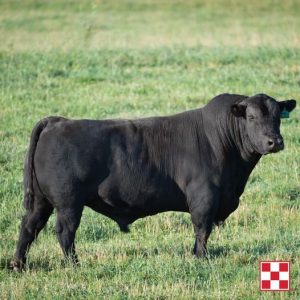For ideal breeding results after spring calving, focus on getting bulls in optimal body condition score during the winter.
Breeding season may seem like it is months away for spring calving herds. However, winter is a vital time to ensure your bulls will be ready to perform at turnout later in spring or summer.
Start the season at the right BCS
Structure, soundness, and fertility are all important factors for a bull’s breeding success, and so is body condition.
Mature bulls should be at a body condition score (BCS) of 6 by turnout, while yearling bulls should be at a 6.5 BCS. Having bulls in proper body condition enhances their ability to perform. Bulls thinner than BCS 6 may have impacted fertility, while over-conditioned bulls have lower libido.1 During the course of a breeding season bulls typically lose 10-15% of their weight (one to two BCS points).
Yearling bulls need a little more condition because they are still growing, and they tend to be more active during the breeding season than older bulls. Having a little extra condition will help yearling bulls make it through their first breeding easier.
For a bull, a one-point change in body condition score equals about 100 pounds. And, it takes time to add condition back on bulls who lost weight during the previous breeding season, so starting to prepare those bulls four or five months out is ideal. Adding one pound per day during the off-season, versus rushing to add on up to three pounds per day as the breeding season closes in, can support your bulls’ longevity.
During a 45 to 90-day breeding season, we’re demanding high performance from bulls. If we can have them in the right shape at the start of the season, the better chance they will perform the way we expect.
Keep bull nutrition in focus
A lot of focus is put on feeding the cowherd and making sure they have what they need during the winter, but we can’t forget about bulls. As forages go dormant during the winter or we move to stored forages, supplemental feed may be needed to make up the nutritional gap.
Self-fed supplements with Intake Modifying Technology® can help remove the burden of feeding bulls daily and keep them on a high plane of nutrition. Purina® Accuration® Hi-Fat blocks are a great way to achieve added body condition when paired with adequate forage and mineral.
Using a Purina® Wind and Rain® Mineral with additional trace minerals, such as Wind and Rain® ProCycle® mineral, ensures ideal trace mineral absorption to support high reproductive expectations.
The same strategy can be employed with a self-feeder, using Accuration® Cattle Limiter or Accuration® Range Supplement 33.
Using self-fed products eliminates competition between bulls at the feeder and the daily task of feeding. Reducing competition helps minimize the risk of injury that could set back your bulls for breeding season.
Depending on winter forage quantity and quality, a Purina® RangeLand® Protein Tub can aid in bridging the nutritional gap.
Start now with bringing your bulls into proper a body condition score so you won’t be playing catch up during the lead into breeding season following spring calving.
Fall calving herd advice
During the winter, fall calving cow herds are in their breeding season.
Although nutritional requirements of bulls in a fall breeding program should be met by forage and diets being supplied to the cowherd they are serving, bulls should be closely monitored for BCS and injury and replaced if need be.
If you’re feeding your cows to a high plane of nutrition with products like Accuration® supplements and ProCycle® mineral, your bulls will get what they need to perform.
Does your nutrition program stack up? Find out with a Proof Pays trial.
Source: Chad Zehnder, Ph.D. Purina Field Cattle Consultant


